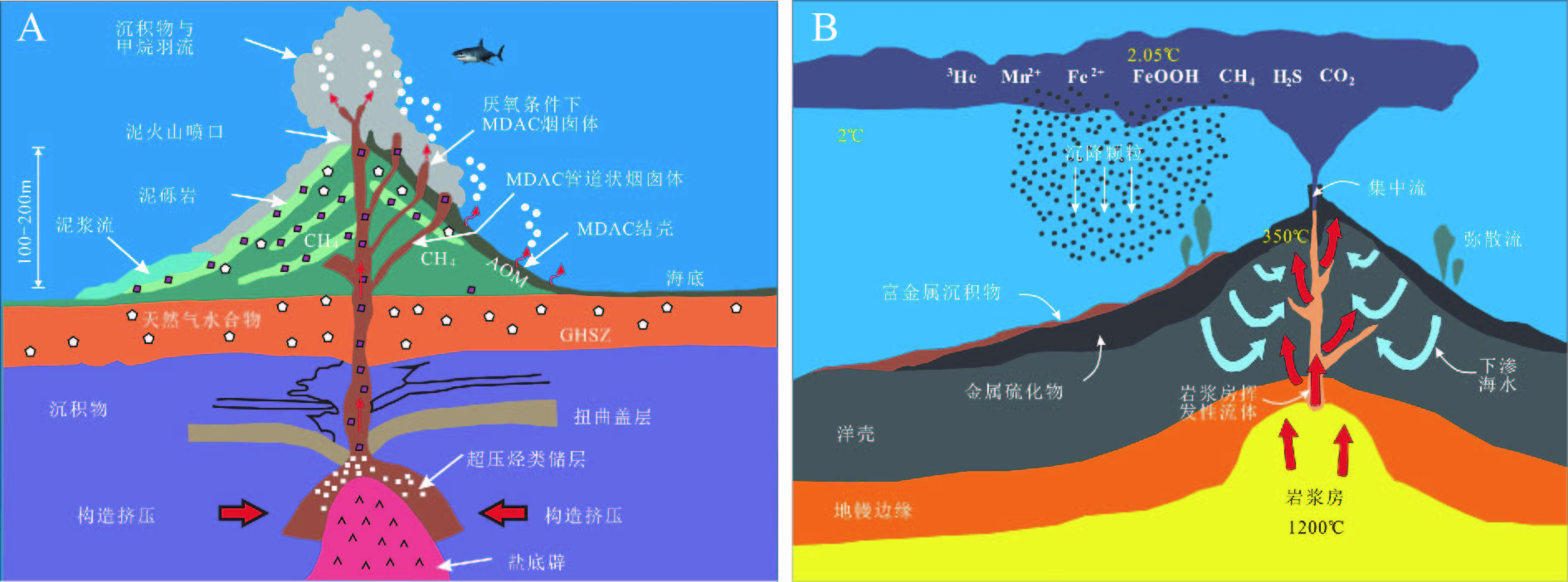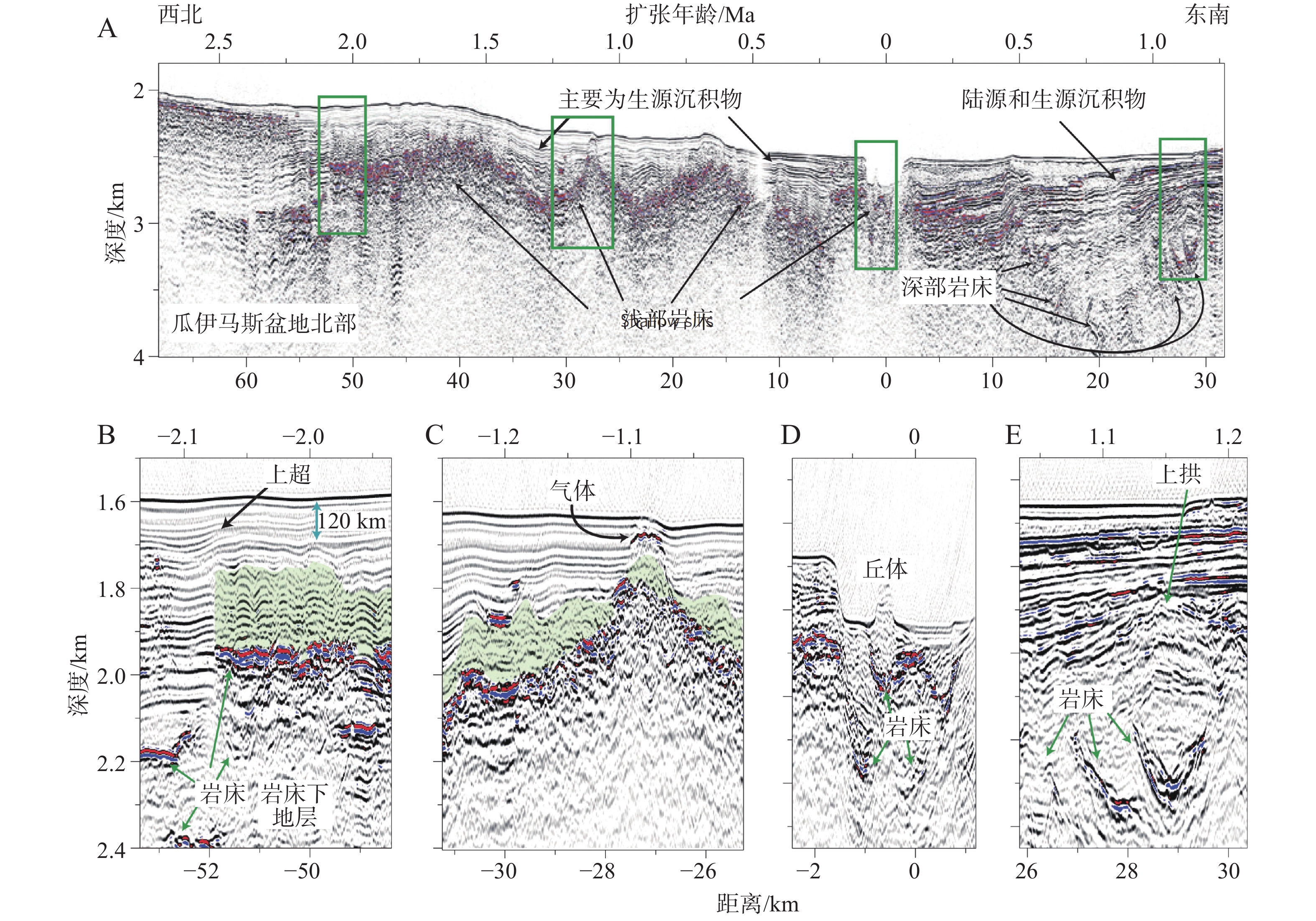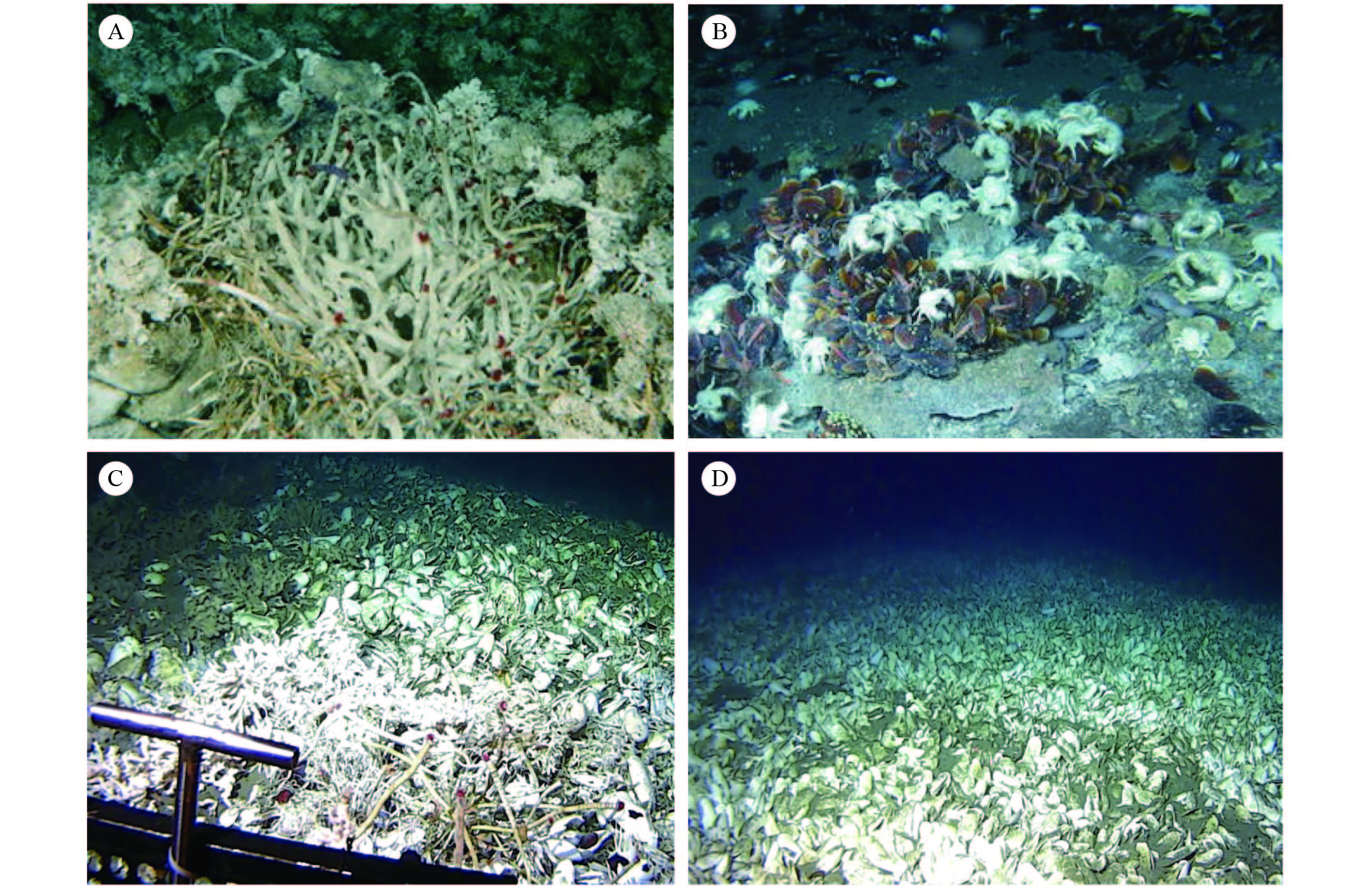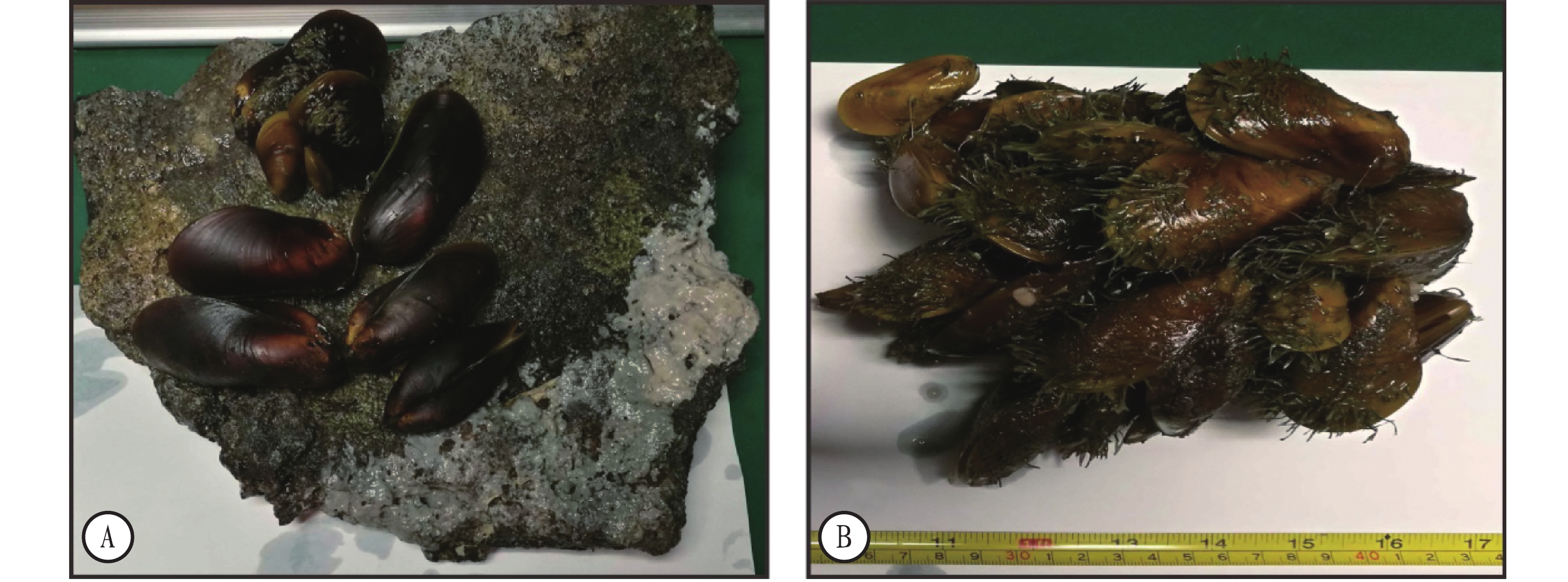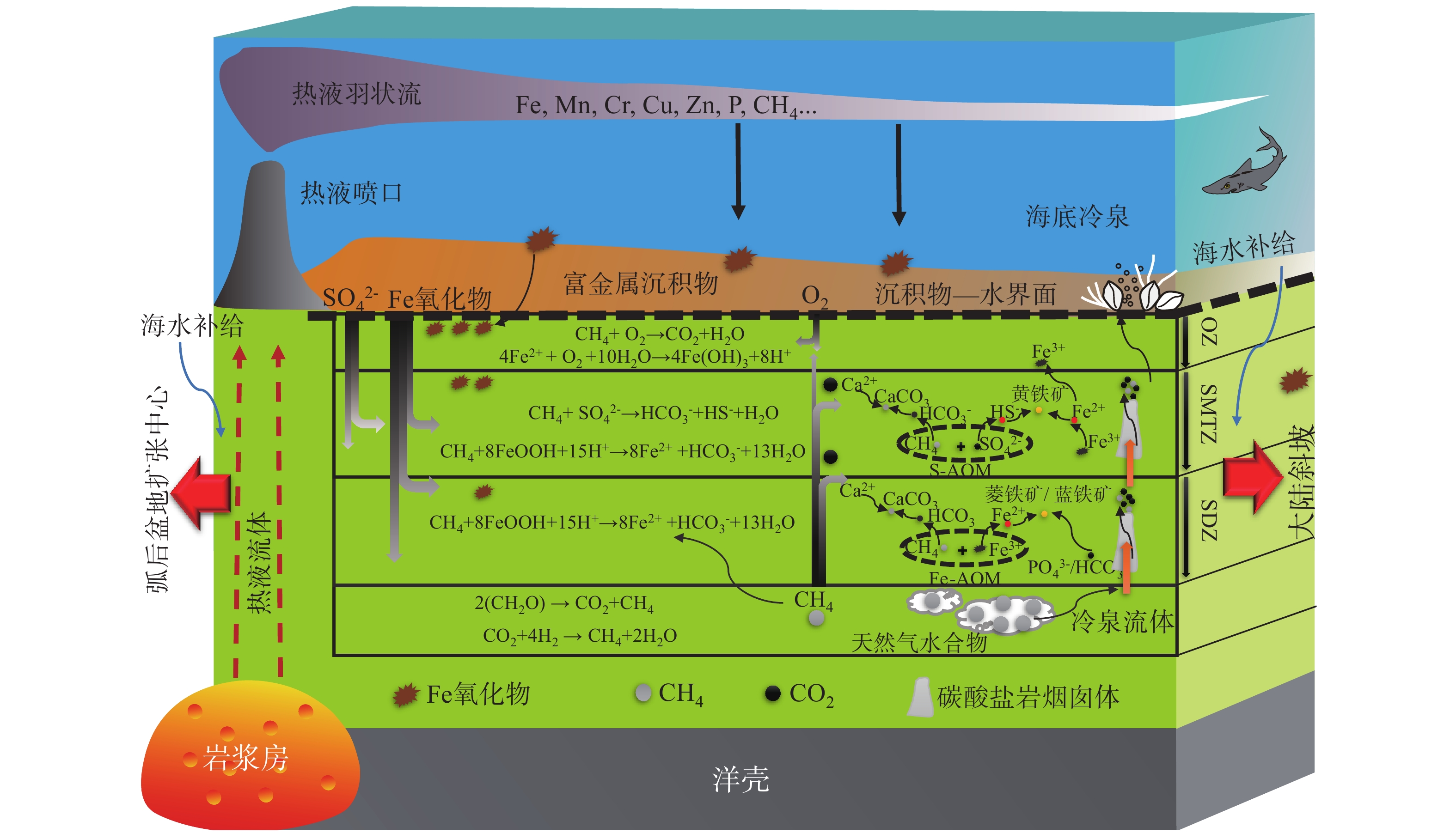Interaction between seafloor cold seeps and adjacent hydrothermal activities in the Okinawa Trough
-
摘要:
热液和冷泉活动是现代深海环境中两个重要的极端系统,它们均是岩石圈与外部圈层之间进行物质、能量转移和交换的重要途径,它们之间既有显著差异,但也存在很多相似点。一系列调查研究表明,在某些特殊构造单元,热液和冷泉活动可能并不是彼此孤立的,而是在构造地质、生物生态和元素循环上存在某种相互作用或耦合关系。冲绳海槽作为西太平洋一个典型的弧后盆地,发育了繁盛的热液和冷泉活动,是研究这两个海底极端系统相互影响机制的天然实验室。在大量文献调研和野外精细探测结果的基础上,分析了冲绳海槽内相互毗邻的冷泉和热液之间的物质扩散过程及生物地球化学作用,初步建立了两个极端系统内两种不同流体相互作用的概念模型,认识到未来如对两个深海极端环境共生区构造发育特征、地层流体演化、生物群落以及矿物元素组成进行系统分析,将有助于建立更加完善的冷泉-热液两个系统在物质和能量上的耦合关系模型,同时也有助于揭示它们在生物生态之间的沟通融合规律,最终可建立盆地尺度上热液-冷泉区相互作用模式,从而加深对西太平洋甚至全球范围内冷泉-热液两个极端环境系统甚至“流体-固体”耦合的规律性认识。
Abstract:As the seafloor extreme environmental systems, both hydrothermal vents and cold seeps are the critical pathways between the lithosphere and exosphere (biosphere, hydrosphere and atmosphere) for transfer and exchange of materials and energies. There are significant differences, but also many similarities between the two systems. Recent investigations show that in some special tectonic units, hydrothermal vents and cold seeps are not isolated from each other, but instead there are some interactions or coupling relationships in terms of tectonic geology, biological ecology and element cyclicity. As a typical back-arc basin in the western Pacific Ocean, there are abundant hydrothermal vents and cold seeps developed in the Okinawa Trough (OT). Therefore, it has become an ideal natural laboratory for studying the two extreme environmental systems and their interactions. On the basis of literature researches and careful field case studies, we investigate the material diffusion process and biogeochemical process between cold seeps and hydrothermal vents adjacent to each other within the trough. A conceptual model is then established for the interactions between the fluids from the two extreme systems. Our results suggest that it would help to establish a more complete model of the coupling relationship between the two systems in the future, if the structural development characteristics, pore fluid evolution, biological communities, and mineral chemistry of the two deep-sea extreme environments are systematically analyzed. Moreover, it will help to reveal the interaction between them in biological ecology and finally establish a model of interaction between hydrothermal vents and cold seeps on the basin scale, so as to better understand the interaction process between cold seeps and hydrothermal systems and even the coupling of “flow-solid” in the Western Pacific Ocean or the whole Earth.
-
Key words:
- hydrothermal activities /
- cold seeps /
- interaction /
- material and energy cycle /
- Okinawa Trough
-

-
图 3 加利福尼亚湾内瓜伊马斯盆地扩张中心附近火成岩与冷泉之间的关系[51]
Figure 3.
表 1 海底冷泉和热液系统之间的异、同特征比较
Table 1. Comparison of the characteristics of seafloor cold seeps and hydrothermal systems
相似点 都具有重要的资源效应 均支持化能自养生物群落 具有相似的环境效应(圈层之间物质和能量交换) 不同点 流体来源和成因机制不同 地质构造和发育位置不同 生化反应和元素循环不同 -
[1] Corliss J B, Dymond J, Gordon L I, et al. Submarine thermal springs on the Galápagos Rift [J]. Science, 1979, 203(4385): 1073-1083. doi: 10.1126/science.203.4385.1073
[2] Paull C K, Hecker B, Commeau R, et al. Biological communities at the Florida escarpment resemble hydrothermal vent taxa [J]. Science, 1984, 226(4677): 965-967. doi: 10.1126/science.226.4677.965
[3] Parson L M, Walker C L, Dixon D R. Hydrothermal vents and processes [J]. Geological Society, London, Special Publication, 1995, 87(1): 1-2. doi: 10.1144/GSL.SP.1995.087.01.01
[4] Judd A, Hovland M. Seabed Fluid Flow: the Impact on Geology, Biology and the Marine Environment[M]. New York: Cambridge University Press, 2009.
[5] Suess E. Marine cold seeps and their manifestations: geological control, biogeochemical criteria and environmental conditions [J]. International Journal of Earth Sciences, 2014, 103(7): 1889-1916. doi: 10.1007/s00531-014-1010-0
[6] Levin L A. Ecology of cold seep sediments: interactions of fauna with flow, chemistry and microbes [J]. Oceanography and Marine Biology-an Annual Review, 2005, 43: 1-46.
[7] Levin L A, Baco A R, Bowden D A, et al. Hydrothermal vents and methane seeps: rethinking the sphere of influence [J]. Frontiers in Marine Science, 2016, 3: 72.
[8] 孙治雷, 何拥军, 李军, 等. 洋底热液喷口系统的微生物成矿研究进展[J]. 海洋地质与第四纪地质, 2011, 31(3):123-132
SUN Zhilei, HE Yongjun, LI Jun, et al. The recent progress of submarine hydrothermal biomineralization [J]. Marine Geology & Quaternary Geology, 2011, 31(3): 123-132.
[9] 孙治雷, 魏合龙, 王利波, 等. 海底冷泉系统的碳循环问题及探测[J]. 应用海洋学学报, 2016, 35(3):442-450 doi: 10.3969/J.ISSN.2095-4972.2016.03.017
SUN Zhilei, WEI Helong, WANG Libo, et al. Focus issues of carbon cycle and detecting technologies in seafloor cold seepages [J]. Journal of Applied Oceanography, 2016, 35(3): 442-450. doi: 10.3969/J.ISSN.2095-4972.2016.03.017
[10] German C R, Seyfried Jr W E. Hydrothermal processes [J]. Treatise on Geochemistry, 2014, 6: 191-233.
[11] Boetius A, Wenzhöfer F. Seafloor oxygen consumption fuelled by methane from cold seeps [J]. Nature Geoscience, 2013, 6(9): 725-734. doi: 10.1038/ngeo1926
[12] Xu N, Wu S G, Shi B Q, et al. Gas hydrate associated with mud diapirs in Southern Okinawa Trough [J]. Marine and Petroleum Geology, 2009, 26(8): 1413-1418. doi: 10.1016/j.marpetgeo.2008.10.001
[13] 孙治雷, 窦振亚, 黄威, 等. 现代海底热液硫化物矿体微生物风化的几个重要研究方向[J]. 海洋地质与第四纪地质, 2014, 34(1):65-74
SUN Zhilei, DOU Zhenya, HUANG Wei, et al. Key issues for microbial weathering study in modern submarine hydrothermal sulfides [J]. Marine Geology & Quaternary Geology, 2014, 34(1): 65-74.
[14] Hannington M, Jamieson J, Monecke T, et al. The abundance of seafloor massive sulfide deposits [J]. Geology, 2011, 39(12): 1155-1158. doi: 10.1130/G32468.1
[15] Kulm L D, Suess E, Moore J C, et al. Oregon subduction zone: venting, fauna, and carbonates [J]. Science, 1986, 231(4738): 561-566. doi: 10.1126/science.231.4738.561
[16] Kelley D S, Karson J A, Früh-Green, G L, et al. A serpentinite-hosted ecosystem: the lost city hydrothermal field [J]. Science, 2005, 307(5714): 1428-1434. doi: 10.1126/science.1102556
[17] Proskurowski G, Lilley M D, Seewald, J S, et al. Abiogenic hydrocarbon production at lost city hydrothermal field [J]. Science, 2008, 319(5863): 604-607. doi: 10.1126/science.1151194
[18] Aharon P, Fu B S. Microbial sulfate reduction rates and sulfur and oxygen isotope fractionations at oil and gas seeps in deep water Gulf of Mexico [J]. Geochimica et Cosmochimica Acta, 2000, 64(2): 233-246. doi: 10.1016/S0016-7037(99)00292-6
[19] MacDonald I R, Bohrmann G, Escobar E, et al. Asphalt volcanism and chemosynthetic life in the Campeche Knolls, Gulf of Mexico [J]. Science, 2004, 304(5673): 999-1002. doi: 10.1126/science.1097154
[20] Skarke A, Ruppel C, Kodis M, et al. Widespread methane leakage from the sea floor on the northern US Atlantic margin [J]. Nature Geoscience, 2014, 7(9): 657-661. doi: 10.1038/ngeo2232
[21] Riedel M, Scherwath M, Römer M, et al. Distributed natural gas venting offshore along the Cascadia margin [J]. Nature Communications, 2018, 9(1): 3264. doi: 10.1038/s41467-018-05736-x
[22] Reysenbach A L, Liu Y T, Banta A B, et al. A ubiquitous thermoacidophilic archaeon from deep-sea hydrothermal vents [J]. Nature, 2006, 442(7101): 444-447. doi: 10.1038/nature04921
[23] Åström E K L, Carroll M L, Ambrose Jr W G, et al. Methane cold seeps as biological oases in the high-Arctic deep sea [J]. Limnology and Oceanography, 2018, 63(S1): S209-S231. doi: 10.1002/lno.10732
[24] Katayama T, Yoshioka H, Takahashi H A, et al. Changes in microbial communities associated with gas hydrates in subseafloor sediments from the Nankai Trough [J]. FEMS Microbiology Ecology, 2016, 92(8): fiw093. doi: 10.1093/femsec/fiw093
[25] Ceramicola S, Dupré S, Somoza L, et al. Cold seep systems[M]//Micallef A, Krastel S, Savini A. Submarine Geomorphology. Cham: Springer, 2018: 367-387.
[26] German C R, Legendre L L, Sander S G, et al. Hydrothermal Fe cycling and deep ocean organic carbon scavenging: model-based evidence for significant POC supply to seafloor sediments [J]. Earth and Planetary Science Letters, 2015, 419: 143-153. doi: 10.1016/j.jpgl.2015.03.012
[27] Yu?cel M, Gartman A, Chan C S, et al. Hydrothermal vents as a kinetically stable source of iron-sulphide-bearing nanoparticles to the ocean [J]. Nature Geoscience, 2011, 4(6): 367-371. doi: 10.1038/ngeo1148
[28] Chapelle F H, O'Neill K, Bradley P M, et al. A hydrogen-based subsurface microbial community dominated by methanogens [J]. Nature, 2002, 415(6869): 312-315. doi: 10.1038/415312a
[29] 陈忠, 杨华平, 黄奇瑜, 等. 海底甲烷冷泉特征与冷泉生态系统的群落结构[J]. 热带海洋学报, 2007, 26(6):73-82 doi: 10.3969/j.issn.1009-5470.2007.06.013
CHEN Zhong, YANG Huaping, HUANG Chiyue, et al. Characteristics of cold seeps and structures of chemoauto-synthesis-based communities in seep sediments [J]. Journal of Tropical Oceanography, 2007, 26(6): 73-82. doi: 10.3969/j.issn.1009-5470.2007.06.013
[30] Sun Z L, Li J, Huang W, et al. Generation of hydrothermal Fe-Si oxyhydroxide deposit on the Southwest Indian Ridge and its implication for the origin of ancient banded iron formations [J]. Journal of Geophysical Research: Biogeosciences, 2015, 120(1): 187-203. doi: 10.1002/2014JG002764
[31] Sun Z L, Wei H L, Zhang X H, et al. A unique Fe-rich carbonate chimney associated with cold seeps in the Northern Okinawa Trough, East China Sea [J]. Deep Sea Research Part I: Oceanographic Research Papers, 2015, 95: 37-53. doi: 10.1016/j.dsr.2014.10.005
[32] Glasby G P, Notsu K. Submarine hydrothermal mineralization in the Okinawa Trough, SW of Japan: an overview [J]. Ore Geology Review, 2003, 23(3-4): 299-339. doi: 10.1016/j.oregeorev.2003.07.001
[33] Alt J C. Subseafloor processes in mid-ocean ridge hydrothennal systems[M]//Humphris S E, Zierenberg R A, Mullineaux L S, et al. Seafloor Hydrothermal Systems: Physical, Chemical, Biological, and Geological Interactions, Volume 91. Washington, DC: American Geophysical Union, 1995: 85-114.
[34] 陈多福, 陈先沛, 陈光谦. 冷泉流体沉积碳酸盐岩的地质地球化学特征[J]. 沉积学报, 2002, 20(1):34-40 doi: 10.3969/j.issn.1000-0550.2002.01.007
CHEN Duofu, CHEN Xianpei, CHEN Guangqian. Geology and geochemistry of cold seepage and venting-related carbonates [J]. Acta Sedimentologica Sinica, 2002, 20(1): 34-40. doi: 10.3969/j.issn.1000-0550.2002.01.007
[35] Talukder A R. Review of submarine cold seep plumbing systems: leakage to seepage and venting [J]. Terra Nova, 2012, 24(4): 255-272. doi: 10.1111/j.1365-3121.2012.01066.x
[36] Pérez-Belzuz F, Alonso B, Ercilla G. History of mud diapirism and trigger mechanisms in the Western Alboran Sea [J]. Tectonophysics, 1997, 282(1-4): 399-422. doi: 10.1016/S0040-1951(97)00226-6
[37] Sautkin A, Talukder A R, Comas M C, et al. Mud volcanoes in the Alboran Sea: evidence from micropaleontological and geophysical data [J]. Marine Geology, 2003, 195(1-4): 237-261. doi: 10.1016/S0025-3227(02)00691-6
[38] Brown K M. The nature and hydrogeologic significance of mud diapirs and diatremes for accretionary systems [J]. Journal of Geophysical Research: Solid Earth, 1990, 95(B6): 8969-8982. doi: 10.1029/JB095iB06p08969
[39] Milkov A V. Worldwide distribution of submarine mud volcanoes and associated gas hydrates [J]. Marine Geology, 2000, 167(1-2): 29-42. doi: 10.1016/S0025-3227(00)00022-0
[40] Dimitrov L I. Mud volcanoes-the most important pathway for degassing deeply buried sediments [J]. Earth-Science Reviews, 2002, 59(1-4): 49-76. doi: 10.1016/S0012-8252(02)00069-7
[41] Talukder A R, Bialas J, Klaeschen D, et al. High-resolution, deep tow, multichannel seismic and sidescan sonar survey of the submarine mounds and associated BSR off Nicaragua pacific margin [J]. Marine Geology, 2007, 241(1-4): 33-43. doi: 10.1016/j.margeo.2007.03.002
[42] Speer K G, Rona P A. A model of an Atlantic and Pacific hydrothermal plume [J]. Journal of Geophysical Research: Oceans, 1989, 94(C5): 6213-6220. doi: 10.1029/JC094iC05p06213
[43] Resing J A, Sedwick P N, German C R. Basin-scale transport of hydrothermal dissolved metals across the South Pacific Ocean [J]. Nature, 2015, 523(7559): 200-203. doi: 10.1038/nature14577
[44] Boström K, Peterson M N A. The origin of aluminum-poor ferromanganoan sediments in areas of high heat flow on the East Pacific Rise [J]. Marine Geology, 1969, 7(5): 427-447. doi: 10.1016/0025-3227(69)90016-4
[45] Reeburgh W S. Oceanic methane biogeochemistry [J]. Chemical Reviews, 2007, 107(2): 486-513. doi: 10.1021/cr050362v
[46] Somoza L, Díaz-del-Río V, León R, et al. Seabed morphology and hydrocarbon seepage in the Gulf of Cádiz mud volcano area: acoustic imagery, multibeam and ultra-high resolution seismic data [J]. Marine Geology, 2003, 195(1-4): 153-176. doi: 10.1016/S0025-3227(02)00686-2
[47] Loher M, Pape T, Marcon Y, et al. Mud extrusion and ring-fault gas seepage-upward branching fluid discharge at a deep-sea mud volcano [J]. Scientific Report, 2018, 8(1): 6275. doi: 10.1038/s41598-018-24689-1
[48] Hannington M D, De Ronde C E J, Petersen S. Sea-floor tectonics and submarine hydrothermal systems[M]//Hedenquist J W, Thompson J F H, Goldfarb R J, et al. Economic Geology 100th Anniversary Volume. Littleton, Colorado: Society of Economic Geologists, 2005: 111-141.
[49] Reeburgh W S. Global methane biogeochemistry [J]. Treatise on Geochemistry, 2007, 4: 1-32.
[50] 吴能友, 梁金强, 王宏斌, 等. 海洋天然气水合物成藏系统研究进展[J]. 现代地质, 2008, 22(3):356-362 doi: 10.3969/j.issn.1000-8527.2008.03.003
WU Nengyou, LIANG Jinqiang, WANG Hongbin, et al. Marine gas hydrate system: state of the art [J]. Geoscience, 2008, 22(3): 356-362. doi: 10.3969/j.issn.1000-8527.2008.03.003
[51] Lizarralde D, Soule S A, Seewald J S, et al. Carbon release by off-axis magmatism in a young sedimented spreading centre [J]. Nature Geoscience, 2011, 4(1): 50-54. doi: 10.1038/ngeo1006
[52] Tsunogai U, Kosaka A, Nakayama N, et al. Origin and fate of deep-sea seeping methane bubbles at Kuroshima Knoll, Ryukyu forearc region, Japan [J]. Geochemical Journal, 2010, 44(6): 461-476. doi: 10.2343/geochemj.1.0096
[53] Seewald J S, Seyfried Jr W E, Thornton E C. Organic-rich sediment alteration: an experimental and theoretical study at elevated temperatures and pressures [J]. Applied Geochemistry, 1990, 5(1-2): 193-209. doi: 10.1016/0883-2927(90)90048-A
[54] Johnson J E, Mienert J, Plaza-Faverola A, et al. Abiotic methane from ultraslow-spreading ridges can charge arctic gas hydrates [J]. Geology, 2015, 43(5): 371-374. doi: 10.1130/G36440.1
[55] 侯增谦, 张绮玲. 冲绳海槽现代活动热水区CO2-烃类流体: 流体包裹体证据[J]. 中国科学(D辑), 1998, 41(4):408-415
HOU Zengqian, ZHANG Qiling. CO2-Hydrocarbon fluids of the Jade hydrothermal field in the Okinawa trough: fluid inclusion evidence [J]. Science in China Series D: Earth Sciences, 1998, 41(4): 408-415.
[56] Watanabe H, Kojima S. Vent fauna in the Okinawa Trough[M]//Ishibashi J I, Okino K, Sunamura M. Subseafloor Biosphere Linked to Hydrothermal Systems. Tokyo: Springer, 2015: 449-459.
[57] Jollivet D. Specific and genetic diversity at deep-sea hydrothermal vents: an overview [J]. Biodiversity & Conservation, 1996, 5(12): 1619-1653.
[58] Micheli F, Peterson C H, Mullineaux L S, et al. Predation structures communities at deep-sea hydrothermal vents [J]. Ecological Monographs, 2002, 72(3): 365-382. doi: 10.1890/0012-9615(2002)072[0365:PSCADS]2.0.CO;2
[59] Tunnicliffe V, Fowler C M R. Influence of sea-floor spreading on the global hydrothermal vent fauna [J]. Nature, 1996, 379(6565): 531-533. doi: 10.1038/379531a0
[60] Beal E J, House C H, Orphan V J. Manganese- and iron-dependent marine methane oxidation [J]. Science, 2009, 325(5937): 184-187. doi: 10.1126/science.1169984
[61] Borowski W S, Rodriguez N M, Paull C K, et al. Are 34S-enriched authigenic sulfide minerals a proxy for elevated methane flux and gas hydrates in the geologic record? [J]. Marine and Petroleum Geology, 2013, 43: 381-395. doi: 10.1016/j.marpetgeo.2012.12.009
[62] Lonsdale P. A deep-sea hydrothermal site on a strike-slip fault [J]. Nature, 1979, 281(5732): 531-534. doi: 10.1038/281531a0
[63] Feng D, Roberts H H. Geochemical characteristics of the barite deposits at cold seeps from the northern Gulf of Mexico continental slope [J]. Earth and Planetary Science Letters, 2011, 309(1-2): 89-99.
[64] Matsumoto R. Isotopically heavy oxygen-containing siderite derived from the decomposition of methane hydrate [J]. Geology, 1989, 17(8): 707-710. doi: 10.1130/0091-7613(1989)017<0707:IHOCSD>2.3.CO;2
[65] Hsu T W, Jiang W T, Wang Y. Authigenesis of vivianite as influenced by methane-induced sulfidization in cold-seep sediments off southwestern Taiwan [J]. Journal of Asian Earth Sciences, 2014, 89: 88-97. doi: 10.1016/j.jseaes.2014.03.027
[66] Morad S, Al-Aasm I S. Conditions of rhodochrosite-nodule formation in Neogene-Pleistocene deep-sea sediments: evidence from O, C and Sr isotopes [J]. Sedimentary Geology, 1997, 114(1-4): 295-304. doi: 10.1016/S0037-0738(97)00066-3
[67] 周琦, 陈建华, 张命桥, 等. 冷泉碳酸盐岩研究进展及成矿意义[J]. 贵州科学, 2007, 25(S1):103-110
ZHOU Qi, CHEN Jianhua, ZHANG Mingqiao, et al. The advances in study and metallogenic significance of cold seep carbonates [J]. Guizhou Science, 2007, 25(S1): 103-110.
[68] Hu W X, Kang X, Cao J, et al. Thermochemical oxidation of methane induced by high-valence metal oxides in a sedimentary basin [J]. Nature Communications, 2018, 9(1): 5131. doi: 10.1038/s41467-018-07267-x
[69] 曾志刚. 海底热液地质学[M]. 北京: 科学出版社, 2011.
ZENG Zhigang. Submarine Hydrothermal Geology[M]. Beijing: Science Press, 2011.
[70] Chiba H, Nakashima, K, Gamo T, et al. Hydrothermal activity at the Minami-Ensei knoll, Okinawa trough: Chemical characteristics of hydrothermal solutions [J]. JAMSTECTR Deep-Sea Research, 1993, 9: 271-282.
[71] Zhang X R, Sun Z L, Fan D J, et al. Compositional characteristics and sources of DIC and DOC in seawater of the Okinawa Trough, East China Sea [J]. Continental Shelf Research, 2019, 174: 108-117. doi: 10.1016/j.csr.2018.12.014
[72] Núñez-Useche F, Canet C, Liebetrau V, et al. Redox conditions and authigenic mineralization related to cold seeps in central Guaymas Basin, Gulf of California [J]. Marine and Petroleum Geology, 2018, 95: 1-15. doi: 10.1016/j.marpetgeo.2018.04.010
[73] Sibuet J C, Letouzey J, Barbier F, et al. Back arc extension in the Okinawa Trough [J]. Journal of Geophysical Research: Solid Earth, 1987, 92(B13): 14041-14063. doi: 10.1029/JB092iB13p14041
[74] 栾锡武, 鲁银涛, 赵克斌, 等. 东海陆坡及邻近槽底天然气水合物成藏条件分析及前景[J]. 现代地质, 2008, 22(3):342-355 doi: 10.3969/j.issn.1000-8527.2008.03.002
LUAN Xiwu, LU Yintao, ZHAO Kebin, et al. Geological factors for the development and newly advances in exploration of gas hydrate in East China Sea Slope and Okinawa Trough [J]. Geoscience, 2008, 22(3): 342-355. doi: 10.3969/j.issn.1000-8527.2008.03.002
-



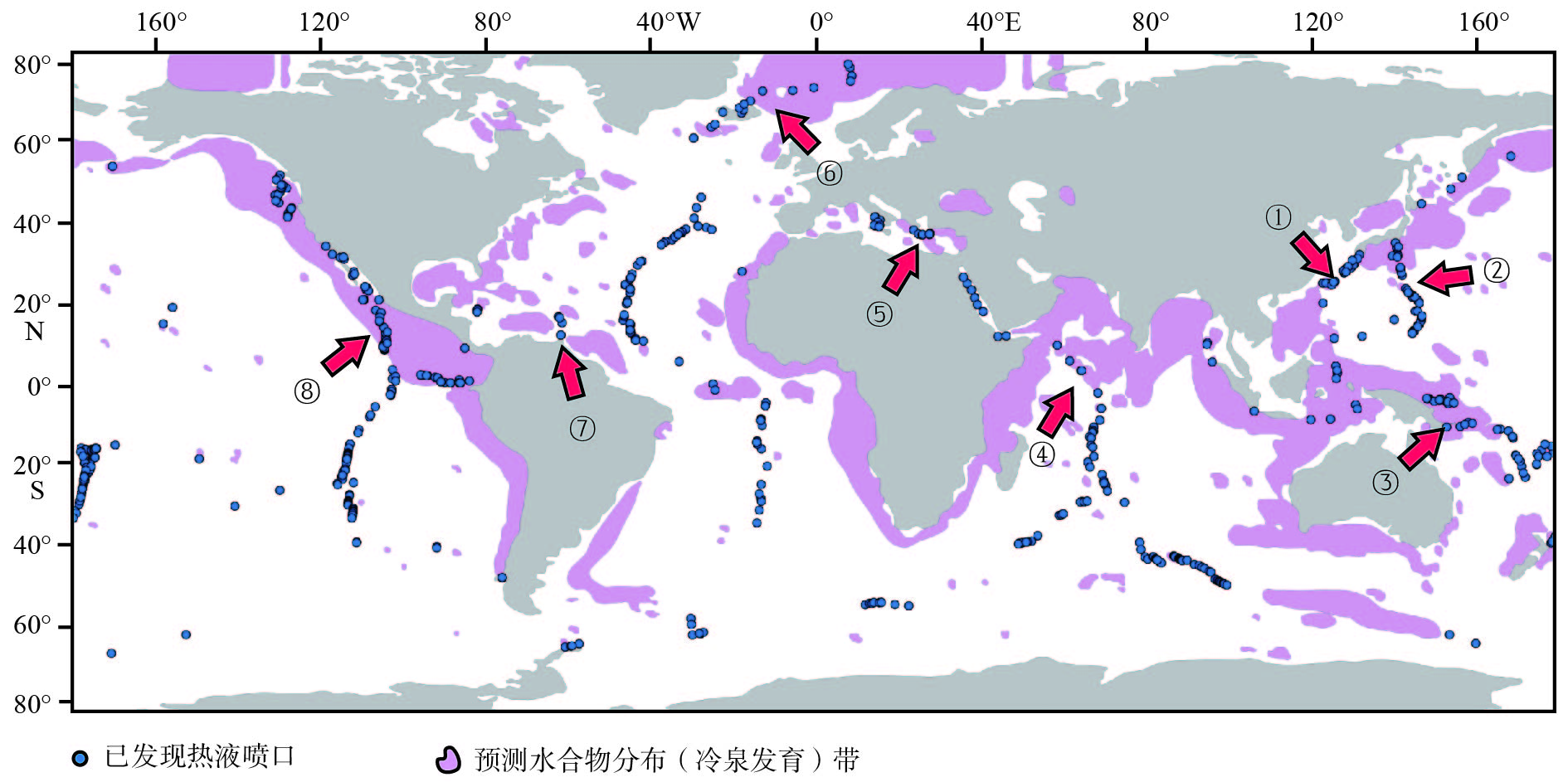
 下载:
下载:
